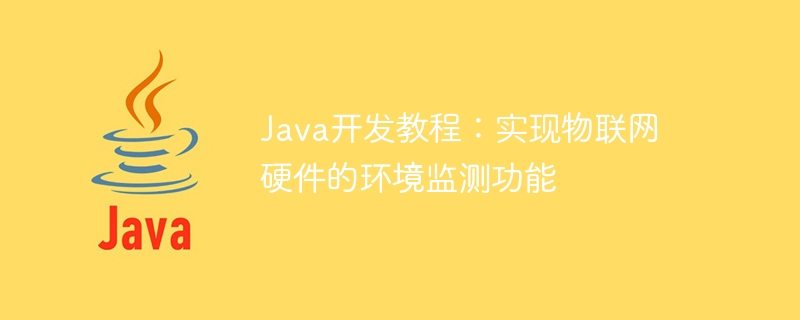Home >Java >javaTutorial >Java Development Tutorial: Implementing the Environmental Monitoring Function of IoT Hardware
Java Development Tutorial: Implementing the Environmental Monitoring Function of IoT Hardware
- 王林Original
- 2023-09-19 12:48:111360browse

Java development tutorial: To implement the environmental monitoring function of IoT hardware, specific code examples are required
Introduction:
With the rapid development of the Internet of Things, more and more Numerous devices and sensors can collect and transmit environmental data. Java, as a popular programming language, can be used to develop IoT applications. This article will introduce how to use Java language to develop a simple IoT environment monitoring function, including collecting data such as temperature, humidity, and light intensity, and uploading the data to the cloud for processing and display.
1. Preparation
-
Hardware equipment:
- Temperature and humidity sensor: used to measure the temperature and humidity of the environment.
- Photoresistor: used to measure the light intensity of the environment.
- Arduino development board: used to read and send sensor data to the computer.
-
Software environment:
- Arduino IDE: used to write and upload programs to the Arduino development board.
- Java development tools (such as Eclipse): used to write Java programs.
2. Hardware connection
First, connect the temperature and humidity sensor and photoresistor to the digital pins of the Arduino development board. In the Arduino IDE, write a simple program that reads the sensor's data and sends it to the computer via the serial port. The sample code is as follows:
#include <DHT.h>
#define DHT_PIN 2
#define DHT_TYPE DHT22
DHT dht(DHT_PIN, DHT_TYPE);
void setup() {
Serial.begin(9600);
dht.begin();
}
void loop() {
float temperature = dht.readTemperature();
float humidity = dht.readHumidity();
int lightIntensity = analogRead(A0);
Serial.print("Temperature: ");
Serial.println(temperature);
Serial.print("Humidity: ");
Serial.println(humidity);
Serial.print("Light Intensity: ");
Serial.println(lightIntensity);
delay(5000);
}After uploading the above code to the Arduino development board, the development board will read the sensor data and send it to the computer through the serial port.
3. Java program development
In the Java development tool, create a new Java project and introduce a serial communication library (such as jSerialComm) to receive data sent by Arduino. The sample code is as follows:
import com.fazecast.jSerialComm.*;
public class ArduinoDataMonitor {
public static void main(String[] args) {
SerialPort port = SerialPort.getCommPort("/dev/tty.usbmodem14201"); // 替换为你的串口号
port.setBaudRate(9600);
if (port.openPort()) {
System.out.println("端口已打开.");
while (true) {
byte[] buffer = new byte[100];
int bytesRead = port.readBytes(buffer, buffer.length);
String arduinoData = new String(buffer, 0, bytesRead);
System.out.println(arduinoData);
// 在这里添加数据处理和上传到云端的代码
try {
Thread.sleep(1000);
} catch (InterruptedException e) {
e.printStackTrace();
}
}
} else {
System.out.println("无法打开串口.");
}
}
}In the above code, we use the serial communication library to get the data sent by Arduino and print it to the console. You can add code for data processing and uploading to the cloud according to your needs.
4. Data processing and uploading
In the above Java program, we can add code for data processing and uploading to the cloud. For example, you can use the HttpClient library to send data to a server or cloud platform. The sample code is as follows:
import com.fazecast.jSerialComm.*;
import org.apache.http.HttpEntity;
import org.apache.http.HttpResponse;
import org.apache.http.client.HttpClient;
import org.apache.http.client.methods.HttpPost;
import org.apache.http.entity.StringEntity;
import org.apache.http.impl.client.HttpClientBuilder;
import java.io.IOException;
import java.util.HashMap;
import java.util.Map;
public class ArduinoDataMonitor {
private static final String POST_URL = "http://example.com/data"; // 替换为你的API地址
public static void main(String[] args) {
// 代码省略...
HttpClient httpClient = HttpClientBuilder.create().build();
HttpPost httpPost = new HttpPost(POST_URL);
Map<String, String> data = new HashMap<>();
data.put("temperature", temperature);
data.put("humidity", humidity);
data.put("lightIntensity", lightIntensity);
ObjectMapper objectMapper = new ObjectMapper();
String dataJson;
try {
dataJson = objectMapper.writeValueAsString(data);
StringEntity entity = new StringEntity(dataJson);
httpPost.setEntity(entity);
httpPost.setHeader("Accept", "application/json");
httpPost.setHeader("Content-type", "application/json");
HttpResponse response = httpClient.execute(httpPost);
HttpEntity responseEntity = response.getEntity();
// 处理服务器响应
} catch (IOException e) {
e.printStackTrace();
}
}
}In the above sample code, we use the HttpClient library to encapsulate the data into JSON format and send it to the server as the content of the HTTP POST request. You can adjust the code to adapt to your API interface according to your own needs.
Summary:
This article introduces how to use Java language to develop a simple IoT environment monitoring function. By connecting the sensor to the Arduino development board and transmitting the data to the computer through serial communication, a Java program is then used for data processing and uploading to the cloud. By adjusting the Java code, you can extend functionality to meet different needs. I hope this article will be helpful to Java developers learning in the field of Internet of Things.
The above is the detailed content of Java Development Tutorial: Implementing the Environmental Monitoring Function of IoT Hardware. For more information, please follow other related articles on the PHP Chinese website!
Related articles
See more- What are the commonly used frameworks in java development?
- The latest java development learning video recommendations
- Is java development front-end or back-end?
- PHP IoT hardware programming operation example: device configuration through code
- Learn PHP Programming: How to Leverage IoT Hardware for Remote Access

